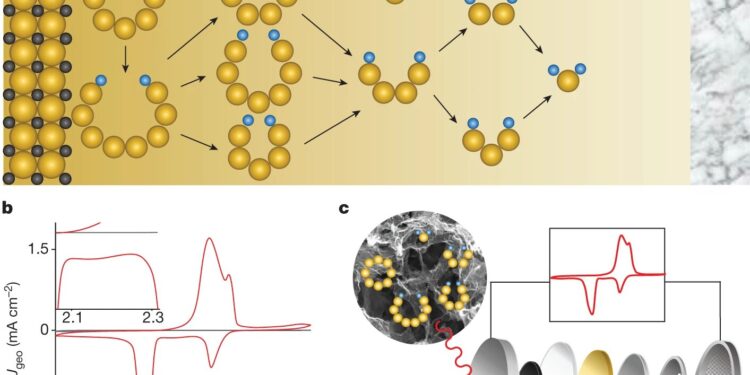Polysulfide conversion reactions involved in the Li-S battery. A, Schematic illustration of the SRR network involved in Li-S battery. The blue and yellow spheres represent lithium and sulfur, respectively. SRR encompasses a sophisticated process of converting 16 electrons from S8 Li molecules2S solid, involving several soluble LiPS intermediates. b, CV of SRR in a Li-S battery with N,S–HGF catalysts. CV data were collected in a coin cell battery at a scan rate of 0.05 mV·s.−1 (see Methods for more details). The black baseline was obtained using the same N,S–HGF in the pristine sulfur-free electrolyte, indicating the negligible contribution of the double-layer capacitance to the overall capacitance. The inset shows the plateau in the approximate voltage range of 2.11 to 2.25 V, which comes from the delayed conversion of Li.2S8 to Li2S4 because of Li2S8+Li2S4 ⇄ 2 Li2S6proportionality/disproportionation reactions. J.geo geometric current density. vs, Schematic illustration of the in situ Raman technique used in this study. Credit: Nature (2024). DOI: 10.1038/s41586-023-06918-4
Lithium-sulfur batteries can potentially store five to ten times more energy than current state-of-the-art lithium-ion batteries, at a much lower cost. Current lithium-ion batteries use cobalt oxide as the cathode, an expensive mineral mined in ways that harm people and the environment. Lithium-sulfur batteries replace cobalt oxide with sulfur, which is abundant and cheap, costing less than a hundredth the price of cobalt.
But there’s a catch: Chemical reactions, particularly the sulfur reduction reaction, are very complex and poorly understood, and unwanted side reactions could end battery life well before that of traditional batteries.
Now, researchers led by UCLA chemists Xiangfeng Duan and Philippe Sautet have deciphered the key pathways of this reaction. These results, presented in an article published in the journal Naturewill help fine-tune the response to improve battery capacity and lifespan.
The sulfur reduction reaction in a lithium-sulfur battery involves 16 electrons to convert an eight-atom cyclic sulfur molecule to lithium sulfide in a catalytic reaction network with many intertwined branches and different intermediate products called lithium-sulfide polysulfides. many other by-products.
Because it is a very complex reaction, with many paths branching off from each other and many intermediate products important for the reaction to continue, it has been difficult to study and even more difficult to determine. which parts of the reaction to target to improve battery performance. .
“Despite considerable effort devoted to improving the apparent performance of lithium-sulfur batteries, the fundamental reaction mechanism remains unclear,” said Duan, corresponding author and professor of chemistry and biochemistry at UCLA. “The main branch of this reaction network for the sulfur reduction reaction remains a subject of considerable debate.”
A particularly interesting problem is a side reaction in which polysulfide intermediates migrate, called shuttles, to and react with the lithium metal anode, consuming both sulfur and lithium and resulting in loss of energy and capacity to storage quickly reduced. Clear identification of key intermediates and a better understanding of how these intermediates are produced or consumed would help scientists control this migration between electrodes and minimize waste of sulfur and lithium.
The new study deciphers the entire reaction network for the first time, determines the dominant molecular pathway, and unveils the critical role of electrocatalysis in altering reaction kinetics.
The team first used theoretical calculations to map all possible reaction pathways and associated intermediates, then electrochemical and spectroscopic analyzes to validate the computational results.
Battery performance was dominated by Li2S4 as the main intermediate, and catalysis was found to be crucial to completely convert Li2S4to the final discharge product (Li2 S). Carbon-based electrodes doped with sulfur and nitrogen can effectively facilitate this conversion.
Their study also found that intermediate Li2S6does not participate directly in the electrochemical process but is present as an important product from secondary chemical reactions and contributes significantly to the undesirable shuttling effect of polysulfide.
“Our study provides a fundamental understanding of the sulfur reduction reaction in lithium-sulfur batteries and demonstrates that a properly designed catalytic electrode material can accelerate charge and discharge reactions, mitigate side reactions, and improve lifespan. of life,” Duan said.
“Combining battery technology and catalysis science opens new avenues for rapid, high-capacity energy conversion devices,” said Sautet, Levi James Knight, Jr. Distinguished Chair . Term.
More information:
Rongli Liu et al, Establishment of reaction networks in the 16-electron sulfur reduction reaction, Nature (2024). DOI: 10.1038/s41586-023-06918-4
Provided by University of California, Los Angeles
Quote: Chemists decipher a reaction process that could improve lithium-sulfur batteries (February 6, 2024) retrieved February 6, 2024 from
This document is subject to copyright. Apart from fair use for private study or research purposes, no part may be reproduced without written permission. The content is provided for information only.



